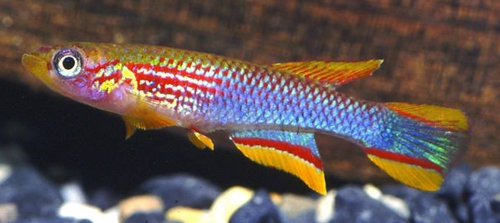Aphyosemion coeleste Huber & Radda 1977

A.coeleste RPC
78 / 5 Titi
Photo courtesy of Gottfried Marschitz
Aphyosemion coeleste Huber & Radda 1977

A.coeleste RPC
78 / 5 Titi
Photo courtesy of Gottfried Marschitz
| Meaning of Name |
Sky blue colouration of body. | ||||||||||||||
| First Description |
Huber J.H & Radda A.C. 1977. Cyprinodontiden Studien in Gabun IV Das du Chaillu Massif. Aquaria 24 : 99-110 (100-102 ?). | ||||||||||||||
| Size |
4 - 4·5cm (Radda & Pürzl 1987) | ||||||||||||||
| Meristics |
D = 11-12, A =14-15, D/A = +7-8, ll = 29-31. | ||||||||||||||
| Karyotype |
| ||||||||||||||
| Sub-Genus |
Mesoaphyosemion | ||||||||||||||
| Group |
A.coeleste | ||||||||||||||
| Synonyms |
| ||||||||||||||
Populations
Ref: KCF website |
RPC 5 - Imported by the BKA Species Import Committee & distributed in February 1980. This population was still in circulation in the UK in 2006 as lots were enterred in the Midland Charity auction.
RPC 15 - A small rainforest stream on the road from Moanda to Mouna near Massango. Height above sea level at this point is 400 metres.
| ||||||||||||||
| Type Locality |
A brook situated close to Massango, 13 km north west of Moanda on the road to Lastoursville, south east Gabon. This is in the Lekedi system which drains into the upper Ogooue drainage system. G16 / 76. | ||||||||||||||
| Distribution |
This sp. has a fairly large distribution area covering southern Gabon & south western Congo. Inhabits the eastern slopes of the Do Chaillu massif & the Louesse River drainage of southern Congo. | ||||||||||||||
| Habitat |
Found
in small forest rivers where the water flows slowly or forms swampy areas. A.coeleste
have been caught under grassy overhangs at the waters edge. Water quality at the
Mbinda location measured pH 6.5, DH 1, water temperature 18·9°C at
1000 hrs. Altitude 400 metres. Measurements taken at an unknown location where this sp. was found on the 7th of August 1976 gave a width of biotope as 1 - 4 metres & depth as 10 - 40 cm. Sympatric sp. included Aphyosemion thysi, Procatopus cf. calindae., Barbus camptacanthus, B.trispilomimus & other Barbus sp., Ctenopoma nanum & Hymenochirus sp. (?).. | ||||||||||||||
| Distinguishing Characteristics |
This sp. is quite variable in colouration with the Mayala population being perhaps the most strikingly coloured with wide marginal & sub-marginal bands. The population from Mbinda differs greatly in that the flanks are relatively un-marked & the sub-marginal band is considerably thinner. The closest relatives of A.coeleste are A.citrinipinnis (which is relatively un-marked apart from a thin band in the anal fin) & A.ocellatum which is easily seperated by the ocellus or spot behind the gill plates. This is absent in A.coeleste. | ||||||||||||||
| Colour/Pattern Variability | Quite high, although most populations have wide outer margins on the un-paired fins. | ||||||||||||||
| History |
First discovered by J.H.Huber & A.C.Radda close to Moanda in August 1976. It was later re-discovered in 1978 in various localities in a large area of western Congo towards Titi. J.Buytaert & W.Wachters found them in 1976 in the Louesse River basin from Mossendjo to Makabana. In 1979 J.H.Huber brought a population back from Malinga in southern Gabon. This location was called JH 213. Purzl & Hofmann also caught this sp. in 1980 at a location called G15 which is situated at Moanda, Gabon. | ||||||||||||||
| Breeding Notes |
Not a prolific spawner. Best kept in cooler water (19 - 21'C). Eggs are fairly large & are usually found near the surface in floating mops & vegetation. Incubation in water takes 2 - 3 weeks but experiments with semi-dry storing have also shown limited success (probably no more than 3 weeks). Food for the fry should be newly hatched brine shrimp & microworm but I always prefer to start them on infusoria for the first few days. Growth rate is fairly slow with the first colours showing through after 3 months & maturity occurring at 6 months. The first signs of males is a red sub-marginal band which appears on the un-paired fins. Young fish are reported not to breed until they reach 6 months of age. A letter accompanying fish sent to me in the early '80's said they had been bred in pH 7.0. Brown mops were used. Eggs layed before the parents reached 6 months of age were infertile. Pürzl & Wachters in BKA Killinews 276
give this account of spawning where they considered water changes with
sudden changes to water quality to cause a failure to spawn, hunger
strikes, shyness & a lack of colouration. Norbert Dadaniak in BKA newsletter No. 300, Sept.
1990 reported putting these eggs on damp peat fibre. Eggs hatched in
12-18 days. Water was added to the fibre when the eyes were visible..
Within a few hours most of the eggs hatched. After 14 days mosquito
egg rafts were floated on the tank. These hatch small enough for the
fry to take. Males were found to colour up quickly & at the size
of 2 cm full colours were observed. | ||||||||||||||
| Diameter of Egg | 1.4mm | ||||||||||||||
| Remarks |
According to letters I received long ago this sp. goes through resting periods where no eggs are layed. The population from Titi seems to be the most often seen in the UK, right back to it's first introduction. Auctions in the UK (1999/2000) still come up with a pair or two. |